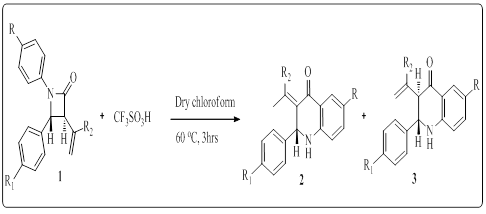
Parvesh Singh
1University of Kwa-Zulu Natal, South Africa
Title: Synthesis of functionalized-2-aryl-2, 3-dihydroquinoline-4(1H)-ones via Fries rearrangement of C-3 conjugated azetidin-2-ones
Biography
Biography: Parvesh Singh
Abstract
Quinoline-4-ones represent an important class of heterocyclic scaffolds that have attracted significant interest due to their various biological and pharmacological activities. This heterocyclic unit also constitutes an integral component in drugs used for the treatment of neurodegenerative diseases, sleep disorders and in antibiotics viz. norfloxacin and ciprofloxacin. The synthetic accessibility and possibility of fictionalization at varied positions in quinoline-4-ones exemplifies an elegant platform for the designing of combinatorial libraries of functionally enriched scaffolds with a range of pharmacological profles. They are also considered to be attractive precursors for the synthesis of medicinally imperative molecules such as non-steroidal androgen receptor antagonists, antimalarial drug chloroquine and martinellines with antibacterial activity. 2-Aryl-2, 3-dihydroquinolin-4(1H)-ones are present in many natural and non-natural compounds and are considered to be the aza-analogs of favanones. The b-lactam class of antibiotics is generally recognized to be a cornerstone of human health care due to the unparalleled clinical efficacy and safety of this type of antibacterial compound. In addition to their biological relevance as potential antibiotics, b-lactams have also acquired a prominent place in organic chemistry as synthons and provide highly efficient routes to a variety of non-protein amino acids, such as oligopeptides, peptidomimetics, nitrogen-heterocycles, as well as biologically active natural and unnatural products of medicinal interest such as indolizidine alkaloids, paclitaxel, docetaxel, taxoids, cyptophycins, lankacidins etc. A straight forward route toward the synthesis of quinoline-4-ones via the triflic acid assisted Fries rearrangement of N-aryl-blactams has been reported by Tepe and co-workers. The ring expansion observed in this case was solely attributed to the inherent ring strain in b-lactam ring because g-lactam failed to undergo rearrangement under reaction conditions. The above mentioned protocol has been recently extended by our group for the synthesis of benzo [b]-azocinon-6-ones via a tandem Michael addition–Fries rearrangement of sorbyl anilides as well as for the single-pot synthesis of 2-aryl-quinolin-4(3H)-ones through the Fries rearrangement of 3-dienyl-blactams. In continuation with our synthetic endeavors with the b-lactam ring and in view of the lack of convenient approaches for the synthesis of C-3 functionalized quinolin-4(1H)-ones, the present work describes the single-pot synthesis of C-3 functionalized quinolin-4(1H)-ones via the triflic acid promoted Fries rearrangement of C-3 vinyl/isopropenyl substituted b-lactams. In addition, DFT calculations and MD simulations were performed to investigate the stability profiles of synthetic compounds.


